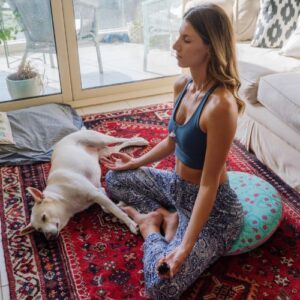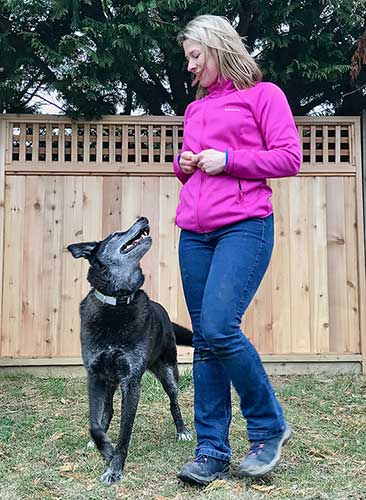Have you taught your dog how to chill out?
 Does your dog know how to settle? Teaching your dog how to chill out should be one of the first things you do when you bring a new dog home. It is such an important skill for any dog to learn. Sadly, it’s one of those things you don’t know you may need to spend time actively teaching until you have a problem on your hands.
Does your dog know how to settle? Teaching your dog how to chill out should be one of the first things you do when you bring a new dog home. It is such an important skill for any dog to learn. Sadly, it’s one of those things you don’t know you may need to spend time actively teaching until you have a problem on your hands.
Anyone who knows us/has worked with us/has followed us online for any period knows that we are huge proponents of “starting as you mean to proceed”. Start training your new addition how to be the dog you want it to be. Whether it’s an 8-week-old puppy or a 6-year-old adoptee, start setting your dog up for success from the very first day you bring it home.
A few essential things for your new dog:
- Potty train – take pup to the designated bathroom as soon as they first come home. Reinforce.
- Containment area – introduce your new dog to their safe space. Whether it’s a crate, a small dog-safe room, or a partitioned area of the house, make sure your new dog has an area that will be safe to leave them in when you can’t actively supervise them. Serve all meals here.
- Limit access to self-reinforcement – see point 2 above. If you are not actively supervising your dog they can be tethered to you or in their containment area. Giving a young/new dog too much freedom in the house sets them up for potty training failure, a lack of focus for you, the development of bad habits, and an inability to spend time quietly by themselves.
- Teach your dog how to relax and spend time alone.
- Enroll in rewards-based private or group training.
- Have fun with your new furry friend.
In the remainder of this post, we’re going to focus on developing the important skill of “relaxation”.
Look online and you’ll find numerous “relaxation protocols”. Ultimately, what we think most people want is just to be able to let their dog “chill out” for a while on their own. What precisely that looks like may differ between clients but we expect most people just want to be able to leave their pup happy and relaxed while they have a shower/make dinner/do some yard work.
Training a “settle”
- Set up confinement area – start independence training by simply being able to feed your dog in their safe space. Additional training may be required – we have plenty of resources to help your dog get comfortable in a crate. We approach an ex-pen setup in the same way.
- Teach your dog both a down and a stay. We combine these two behaviors with our mat-work exercises.
- Build duration for your dog remaining on their mat and in their confinement area – start with just very brief departures. Perhaps you have to stay in sight. Return to your dog and calmly reward in place. Repeat.
- Grab a coffee and a book and sit close to pup while they are lying in their confinement area. Every once in a while you will calmly mark and treat for them just lying there. Mealtimes offer a great opportunity for this exercise. You can dole out your dog’s meal in small portions as long as they remain lying calmly.
- Build duration further by giving your dog a long-lasting food toy while you leave them in their confinement area.
Reinforce real relaxation

Teaching your dog how to relax is an important skill.
The hardest part of the training is knowing how to disengage from your dog while still keeping an eye on what they’re doing. Ideally what we want to be able to do is reward the dog intermittently for choosing to stay calm. For some dogs this will be such a small amount of time when you begin then they get pushy, and frustrated and are likely to jump and bark. We want to avoid these behaviors as far as possible. It is much more effective from a training point of view to progress slowly from a place of calm than to try to do too much and end up with a dog practicing demand behaviors.
Watch their body language (again, from an indirect observation. This shouldn’t be a staring situation.) Are they lying down? Do they look relaxed or are they standing/pacing/panting heavily? You want to reward the moments when your dog chooses to relax. But do it calmly yourself. You should look like you’re relaxing. At times your dog may stir in the hope of getting your attention. Try and wait for them to make their own decision to sit or lie down. If every time your dog gets up, they receive your attention and another cue to sit or lie down then they will keep on doing it. We need to make the behavior we want the more reinforcing choice. But we also don’t just want your dog offering behaviors in return for treats. Calm, low-intensity reinforcement from you is key.
But what do I do if Fido won’t relax?
For some dogs you may need to get up and walk away when they start fussing. Only return when they exercise some degree of self-control – 4 feet on the floor, sitting, or just being quiet for example. Again, for some dogs you will have to reward the smallest amount of success. For some dogs you may have to keep them on leash and start with “Sit on the Dog”. For many dogs, the only place they can really relax is in their crate. There is a degree of just finding out what works best for your dog. And again, the sooner you can start this training the better. It is so much easier to train a new puppy/adopted dog that the confinement area is a great place, that life will go on if you are not with them, and that good choices are the key to getting out (for example offered sits/down/not door rushing) than trying to get a dog to calmly hang out if they have never previously faced limits on their freedom.
Effective behavior change will take time. To be successful you will have to build the behaviors you want. Start at a training level where your dog can achieve success and progress from there. If your dog is struggling at any level then you are trying to move ahead too quickly. Adjust what you’re doing by making something a little easier for your dog. Get success and then try progressing again.


